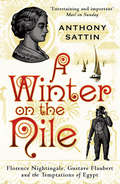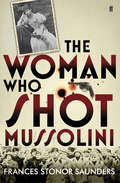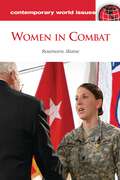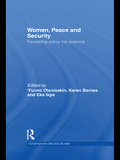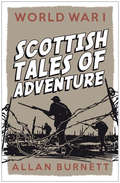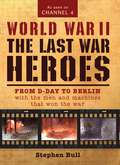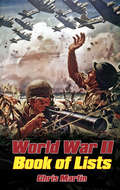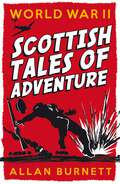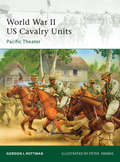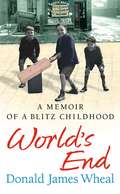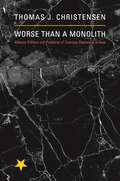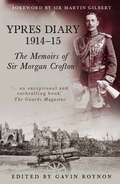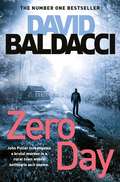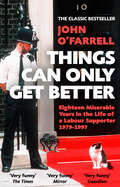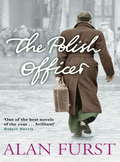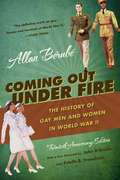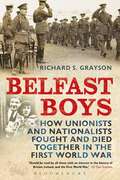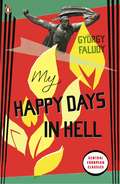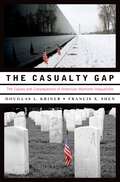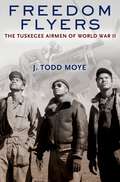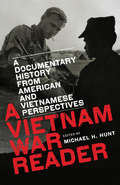- Table View
- List View
A Winter on the Nile
by Anthony SattinIn the winter of 1849, Florence Nightingale was an unknown 29-year-old - beautiful, well-born and deeply unhappy. After clashing with her parents over her refusal to marry, she had been offered a lifeline by family friends who suggested a trip to Egypt, a country which she had always longed to visit.By an extraordinary coincidence, taking the same boat from Alexandria was an unpublished French writer, Gustave Flaubert. Like Nightingale, he was at the crossroads in his life that was to lead to futureacclaim and literary triumph. Egypt for him represented escape and freedom as well as inspiration.But as a wealthy young man travelling with male friends, he had access to an altogether different Egpyt: where Nightingale sought out temples and dispensaries, Flaubert visited brothels and harems.In this beguiling book, Anthony Sattin takes a key moment in the lives of two extraordinary figures on the brink of international fame, and provides a fascinating insight into the early days of travel to one ofthe greatest tourist destinations on the planet.
The Woman Who Shot Mussolini: A Biography
by Frances Stonor SaundersA gripping account of the life and fate of the woman who almost assassinated Benito Mussolini.7 April 1926: on the steps of the Capitol in Rome, surrounded by chanting Fascists, The Honourable Violet Gibson raises her old revolver and fires at the Italian head of state, Benito Mussolini - the darling of Europe's ruling class. The bullet narrowly misses the dictator's bald head, hitting him in the nose. Of all his would-be assassins, she came closest to changing the course of history.What brought her to this moment? The daughter of an Anglo-Irish lord, she had once consorted with royalty and the peerage. Yet terrible unhappiness lurked beneath that glittering surface. She loved Italy and when Mussolini's thugs took it into the moral cesspit of Fascism, she felt she had to act.She paid for it for the rest of her life, confined to a lunatic asylum, like other difficult women of her class. Frances Stonor Saunders' moving and compulsively readable book rescues this gentle, driven woman from a silent void and restores her dignity and purpose.
Women in Combat: A Reference Handbook (Contemporary World Issues)
by Rosemarie SkaineThis handbook provides a straightforward account of how women have served in combat roles and explains the ongoing controversy surrounding efforts to legalize combat assignments for female service members.Women have been excluded from combat roles for most of American history. During conflicts such as the American Civil War, a few women enlisted as men; in some cases, their identities as women were not discovered until after their deaths. Today, the nontraditional battlefields of Iraq and Afghanistan have no clearly defined front lines, and many female soldiers have found themselves face-to-face with the enemy. Yet despite the realities of modern warfare, the subject of women serving in combat roles remains highly controversial.Women in Combat: A Reference Handbook examines the historical background, current dilemmas, and global context of this contentious issue. The author explores both sides of the argument, presenting information from leading sources and gleaned from personal interviews. Statistical data, primary source documents, a directory of organizations, and print and electronic resources offer additional insight.
Women in Combat: A Reference Handbook (Contemporary World Issues)
by Rosemarie SkaineThis handbook provides a straightforward account of how women have served in combat roles and explains the ongoing controversy surrounding efforts to legalize combat assignments for female service members.Women have been excluded from combat roles for most of American history. During conflicts such as the American Civil War, a few women enlisted as men; in some cases, their identities as women were not discovered until after their deaths. Today, the nontraditional battlefields of Iraq and Afghanistan have no clearly defined front lines, and many female soldiers have found themselves face-to-face with the enemy. Yet despite the realities of modern warfare, the subject of women serving in combat roles remains highly controversial.Women in Combat: A Reference Handbook examines the historical background, current dilemmas, and global context of this contentious issue. The author explores both sides of the argument, presenting information from leading sources and gleaned from personal interviews. Statistical data, primary source documents, a directory of organizations, and print and electronic resources offer additional insight.
Women, Peace and Security: Translating Policy into Practice (Contemporary Security Studies)
by ’Funmi OlonisakinThis book provides a critical assessment of the impact of UN Resolution 1325 by examining the effect of peacebuilding missions on increasing gender equality within conflict-affected countries. UN Resolution 1325 was adopted in October 2000, and was the first time that the security concerns of women in situations of armed conflict and their role in peacebuilding was placed on the agenda of the UN Security Council. It was an important step forward in terms of bringing women’s rights and gender equality to bear in the UN’s peace and security agenda. More than a decade after the adoption of this Resolution, its practical reality is yet to be substantially felt on the ground in the very societies and regions where women remain disproportionately affected by armed conflict and grossly under-represented in peace processes. This realization, in part, led to the adoption in 2008 and 2009 of three other Security Council Resolutions, on sexual violence in conflict, violence against women, and for the development of indicators to measure progress in addressing women, peace and security issues. The book draws together the findings from eight countries and four regional contexts to provide guidance on how the impact of Resolution 1325 can be measured, and how peacekeeping operations could improve their capacity to effectively engender security. This book will be of much interest to students of peacebuilding, gender studies, the United Nations, international security and IR in general.
Women, Peace and Security: Translating Policy into Practice (Contemporary Security Studies)
by Funmi Olonisakin Karen Barnes Eka IkpeThis book provides a critical assessment of the impact of UN Resolution 1325 by examining the effect of peacebuilding missions on increasing gender equality within conflict-affected countries. UN Resolution 1325 was adopted in October 2000, and was the first time that the security concerns of women in situations of armed conflict and their role in peacebuilding was placed on the agenda of the UN Security Council. It was an important step forward in terms of bringing women’s rights and gender equality to bear in the UN’s peace and security agenda. More than a decade after the adoption of this Resolution, its practical reality is yet to be substantially felt on the ground in the very societies and regions where women remain disproportionately affected by armed conflict and grossly under-represented in peace processes. This realization, in part, led to the adoption in 2008 and 2009 of three other Security Council Resolutions, on sexual violence in conflict, violence against women, and for the development of indicators to measure progress in addressing women, peace and security issues. The book draws together the findings from eight countries and four regional contexts to provide guidance on how the impact of Resolution 1325 can be measured, and how peacekeeping operations could improve their capacity to effectively engender security. This book will be of much interest to students of peacebuilding, gender studies, the United Nations, international security and IR in general.
World War I: Scottish Tales of Adventure
by Allan BurnettAcclaimed children's author Allan Burnett turns his attention to the First World War in a book of explosively exciting and emotionally charged tales of bravery and adventure. Featuring the true exploits of soldiers, spies, pilots, sailors and many others, these stories, all based on interviews with these heroes themselves or their descendants, offer a unique, personal insight into the First World War that no conventional history book can ever hope to match.
World War II: From D-Day to Berlin with the men and machines that won the war
by Dr Stephen BullThe companion volume to the groundbreaking TV series, this book tells the story of the physical, emotional and psychological journey of Allied soldiers from the beaches of Normandy to the ruins of Berlin. In their own words these brave men from Britain, the United States, Canada and Russia tell us what it was like to face the bullets, bombs, mortars, mines and artillery shells of Nazi Germany. Interviews with over 80 soldiers who fought in the conflict, totalling 150 hours, provide a new perspective on the experiences of 1944–45. Building on the high-speed, multi-camera filming of World War II weapons and munitions shown in the TV series, this book brings the terrifying reality of the war to life. Technical descriptions and the experiences of the men in the field explain the dramatic power and effect that this weaponry had on the battlefield, from the sinister simplicity of the deadly AP mine through to the immense firepower of the 88mm gun, giving the modern historian a unique insight into the last days of the war for the troops on the frontline. This is not a history of generals, of armies manoeuvring and strategic objectives. It is a book about the ordinary men put into incredible situations, deprived of sleep and food, and in constant fear of death on the long road to victory.
World War II: The Book of Lists
by Chris MartinEverything you ever wanted to know about the Second World War, from the highest-rated fighter aces to the most inventive escape equipment used to break out of Colditz; from army pay by rank to the largest battleships; from the most stirring speeches to the biggest tactical errors; from the strangest regimental mottoes to the plays most performed by ENSA; and from the dates each country joined the war to the most unlikely spies. All the major events and dates in the war are covered in detail, but equal emphasis is placed on the human experience of combat. Often poignant and always revealing, World War II: the Book of Lists offers a unique insight into the deadliest conflict in human history.
World War II: Scottish Tales of Adventure
by Allan BurnettAcclaimed children's author Allan Burnett turns his attention to the Second World War in a book of explosively exciting and emotionally charged tales of bravery and adventure. Featuring the true exploits of soldiers, spies, pilots, sailors and many others, these stories, all based on interviews with these heroes themselves or their descendants, offer a unique, personal insight into the Second World War that no conventional history book can ever hope to match.
The World War II Story (Story Ser.)
by Chris McNabIn September 1939, Hitler’s Nazi Germany invaded Poland. Thus began the greatest armed struggle in history. Within days of the invasion, Germany was at war with France, Great Britain and much of the Commonwealth, but by the end of 1941 – by which time Japan and the United States had been plunged into war – the conflict had engulfed virtually the entire planet. World War II witnessed the mobilisation of more than 100 million military personnel. Here was ‘total war’ on a scale never previously experienced by any of the countries involved. The conflict eclipsed everything: industry, technology, the economy and home life. It transformed the lives of an entire generation of men and women, who grew up under the shadow of violence, separation and loss. It was also fought in every conceivable terrain and theatre, from the arctic conditions of the Soviet winter to the tropical landscape of the Pacific islands, with the battle for seas and skies being equally brutal. By the time it ended in September 1945, World War II had claimed the lives of more than 50 million people, and it witnessed the only use of nuclear weapons in warfare to this day. The World War II Story charts the dramatic narrative of the conflict from its first shots to its final apocalyptic end.
World War II US Cavalry Units: Pacific Theater (Elite #175)
by Peter Dennis Gordon L. RottmanAt the time of Pearl Harbor, the United States Army still had ten cavalry regiments.The 26th (Filipino Scouts) fought on horseback in the Philippines, while the rest were fought as infantry. Despite this, the cavalry units maintained their own unique traditions, and identity as they saw action in the Pacific and China-Burma-India theatre. This book covers all of the US cavalry units to see action during World War II. It includes the little-covered Texan National Guard regiments, who fought beside ex-Merrill's Marauders as a deep penetration unit. It also contains color-plates of the uniforms of the US Army's last mounted cavalry as well as tropical combat dress worn by the dismounted units.
World's End: A Memoir Of A Blitz Childhood
by Donald JamesWorld's End is the story of Donald Wheal¹s childhood in Chelsea's World's End at the height of the Second World War.Not for him the privileged bohemian world of Chelsea a few hundred yards away. Descended from rural immigrants, ladies of the night and bare-knuckle fighters, Donald Wheal¹s upbringing took place amidst grimy factories and generating plants, illegal street bookmakers, dog tracks, tenements and street walkers who plied their trade in Piccadilly and Soho. World's End is the story of how he and his family struggled free from this underclass. It is also an individual history of the Second World War, of a small boy¹s grappling with the bitter separation of evacuation, the return to an already battered London, the wonderland of bomb-damaged houses to play in, and the nights of terror as the Blitz returned.
Worse Than a Monolith: Alliance Politics and Problems of Coercive Diplomacy in Asia
by Thomas J. ChristensenIn brute-force struggles for survival, such as the two World Wars, disorganization and divisions within an enemy alliance are to one's own advantage. However, most international security politics involve coercive diplomacy and negotiations short of all-out war. Worse Than a Monolith demonstrates that when states are engaged in coercive diplomacy--combining threats and assurances to influence the behavior of real or potential adversaries--divisions, rivalries, and lack of coordination within the opposing camp often make it more difficult to prevent the onset of conflict, to prevent existing conflicts from escalating, and to negotiate the end to those conflicts promptly. Focusing on relations between the Communist and anti-Communist alliances in Asia during the Cold War, Thomas Christensen explores how internal divisions and lack of cohesion in the two alliances complicated and undercut coercive diplomacy by sending confusing signals about strength, resolve, and intent. In the case of the Communist camp, internal mistrust and rivalries catalyzed the movement's aggressiveness in ways that we would not have expected from a more cohesive movement under Moscow's clear control. Reviewing newly available archival material, Christensen examines the instability in relations across the Asian Cold War divide, and sheds new light on the Korean and Vietnam wars. While recognizing clear differences between the Cold War and post-Cold War environments, he investigates how efforts to adjust burden-sharing roles among the United States and its Asian security partners have complicated U.S.-China security relations since the collapse of the Soviet Union.
Worse Than a Monolith: Alliance Politics and Problems of Coercive Diplomacy in Asia
by Thomas J. ChristensenIn brute-force struggles for survival, such as the two World Wars, disorganization and divisions within an enemy alliance are to one's own advantage. However, most international security politics involve coercive diplomacy and negotiations short of all-out war. Worse Than a Monolith demonstrates that when states are engaged in coercive diplomacy--combining threats and assurances to influence the behavior of real or potential adversaries--divisions, rivalries, and lack of coordination within the opposing camp often make it more difficult to prevent the onset of conflict, to prevent existing conflicts from escalating, and to negotiate the end to those conflicts promptly. Focusing on relations between the Communist and anti-Communist alliances in Asia during the Cold War, Thomas Christensen explores how internal divisions and lack of cohesion in the two alliances complicated and undercut coercive diplomacy by sending confusing signals about strength, resolve, and intent. In the case of the Communist camp, internal mistrust and rivalries catalyzed the movement's aggressiveness in ways that we would not have expected from a more cohesive movement under Moscow's clear control. Reviewing newly available archival material, Christensen examines the instability in relations across the Asian Cold War divide, and sheds new light on the Korean and Vietnam wars. While recognizing clear differences between the Cold War and post-Cold War environments, he investigates how efforts to adjust burden-sharing roles among the United States and its Asian security partners have complicated U.S.-China security relations since the collapse of the Soviet Union.
Ypres Diary 1914-15: The Memoirs of Sir Morgan Crofton
by Gavin RoynonSir Morgan Crofton fought in the Boer War and joined the 2nd Life Guards at 34 years old as a cavalry office. His diary charts his experiences on the front-line at Ypres from late October 1914 to the centenary of Waterloo in June 1915. Crofton describes a battlefield a world away from what he and any of his comrades had experienced before - one of staying still in trenches, being pounded by artillery and the terrifying new power of machine guns. He describes the bewildering pace of technological change as new weapons, such as gas and hand grenades entered the fray. His often ascerbic commentary offers a fascinating glimpse into the mindset of the regular officer class and his outspoken scepticism informs our understanding of a lost generation of professional soldiers.
Zero Day (John Puller series #1)
by David BaldacciZero Day is the explosive first instalment in David Baldacci's thrilling John Puller series. Distinguished as a top investigator in the US government, John Puller is called in to conduct an enquiry into the brutal murders of a family in a remote area of West Virginia. It soon becomes clear that the case has wider implications and as the body count rises he teams up with local homicide detective Samantha Cole. As the web of deceit is revealed, it quickly becomes apparent that there's much more to this case than they had first thought. It is an investigation where nothing is as it seems, and nothing can be taken at face value. When Puller and Cole discover a dangerous situation in the making, Puller finds he must turn to the one person who can help avert certain catastrophe. A person he has known all his life. In a breathtaking rollercoaster race against time, Cole fears for the community in which she was raised, and Puller knows he has to overcome the enemies of his country to avoid far reaching disaster. But in the end, you can't kill what you can't see is coming . . .
Things Can Only Get Better
by John O'FarrellLike bubonic plague and stone cladding, no-one took Margaret Thatcher seriously until it was too late. Her first act as leader was to appear before the cameras and do a V for Victory sign the wrong way round. She was smiling and telling the British people to f*** off at the same time. It was something we would have to get used to.'Things Can Only Get Better is the personal account of a Labour supporter who survived eighteen miserable years of Conservative government. It is the heartbreaking and hilarious confessions of someone who has been actively involved in helping the Labour party lose elections at every level: school candidate: door-to-door canvasser: working for a Labour MP in the House of Commons; standing as a council candidate; and eventually writing jokes for a shadow cabinet minister.Along the way he slowly came to realise that Michael Foot would never be Prime Minister, that vegetable quiche was not as tasty as chicken tikki masala and that the nuclear arms race was never going to be stopped by face painting alone.
The Polish Officer
by Alan FurstFrom the master of the historical spy thriller, a story set in the heart of the Polish resistanceSeptember, 1939. The invading Germans blaze a trail of destruction across Poland. France and Britain declare war, but do nothing to help. And a Polish resistance movement takes shape under the shadow of occupation, enlisting those willing to risk death in the struggle for their nation's survival. Among them is Captain Alexander de Milja, an officer in the Polish military intelligence service, a cartographer who now must learn a dangerous new role: spymaster in the anti-Nazi underground. Beginning with a daring operation to smuggle the Polish National Gold Reserve to the government in exile, he slips into the shadowy and treacherous front lines of espionage; he moves through Europe, changing identities and staying one step ahead of capture. In Warsaw, he engineers a subversive campaign to strengthen the people's will to resist. In Paris, he poses as a Russian poet, then as a Slovakian coal merchant, drinking champagne in black-market bistros with Nazis while uncovering information about German battle plans. And a love affair with a woman of the French Resistance leads him to make the greatest decision of his life.
Coming Out Under Fire: The History of Gay Men and Women in World War II
by Allan BérubéDuring World War II, as the United States called on its citizens to serve in unprecedented numbers, the presence of gay Americans in the armed forces increasingly conflicted with the expanding antihomosexual policies and procedures of the military. In Coming Out Under Fire, Allan Berube examines in depth and detail these social and political confrontation--not as a story of how the military victimized homosexuals, but as a story of how a dynamic power relationship developed between gay citizens and their government, transforming them both. Drawing on GIs' wartime letters, extensive interviews with gay veterans, and declassified military documents, Berube thoughtfully constructs a startling history of the two wars gay military men and women fough--one for America and another as homosexuals within the military.Berube's book, the inspiration for the 1995 Peabody Award-winning documentary film of the same name, has become a classic since it was published in 1990, just three years prior to the controversial "don't ask, don't tell" policy, which has continued to serve as an uneasy compromise between gays and the military. With a new foreword by historians John D'Emilio and Estelle B. Freedman, this book remains a valuable contribution to the history of World War II, as well as to the ongoing debate regarding the role of gays in the U.S. military.
Belfast Boys: How Unionists and Nationalists Fought and Died Together in the First World War
by Richard S. GraysonThis is the story of men from either side of West Belfast's sectarian divide during the Great War. Richard S. Grayson follows the volunteers of the 36th and 16th divisions who fought on the Somme and side-by-side at Messines, recovering the forgotten West Belfast men throughout the armed forces, from the retreat at Mons to the defeat of Germany and life post-war. In so doing, he tells a new story which challenges popular perceptions of the war and explains why remembrance remains so controversial in Belfast today.
My Happy Days In Hell
by György FaludyMy Happy Days in Hell (1962) is Gyorgy Faludy's grimly beautiful autobiography of his battle to survive tyranny and oppression. Fleeing Hungary in 1938 as the German army approaches, acclaimed poet Faludy journeys to Paris, where he finds a lover but merely a cursory asylum. When the French capitulate to the Nazis, Faludy travels to North Africa, then on to America, where he volunteers for military service. Missing his homeland and determined to do the right thing, he returns - only to be imprisoned, tortured, and slowly starved, eventually becoming one of only twenty-one survivors of his camp.
The Casualty Gap: The Causes and Consequences of American Wartime Inequalities
by Douglas L. Kriner Francis X. ShenThe Casualty Gap shows how the most important cost of American military campaigns--the loss of human life--has been paid disproportionately by poorer and less-educated communities since the 1950s. Drawing on a rich array of evidence, including National Archives data on the hometowns of more than 400,000 American soldiers killed in World War II, Korea, Vietnam, and Iraq, this book is the most ambitious inquiry to date into the distribution of American wartime casualties across the nation, the forces causing such inequalities to emerge, and their consequences for politics and democratic governance.
Freedom Flyers: The Tuskegee Airmen of World War II (Oxford Oral History Series)
by J. Todd MoyeAs the country's first African American military pilots, the Tuskegee Airmen fought in World War II on two fronts: against the Axis powers in the skies over Europe and against Jim Crow racism and segregation at home. Although the pilots flew more than 15,000 sorties and destroyed more than 200 German aircraft, their most far-reaching achievement defies quantification: delivering a powerful blow to racial inequality and discrimination in American life. In this inspiring account of the Tuskegee Airmen, historian J. Todd Moye captures the challenges and triumphs of these brave pilots in their own words, drawing on more than 800 interviews recorded for the National Park Service's Tuskegee Airmen Oral History Project. Denied the right to fully participate in the U.S. war effort alongside whites at the beginning of World War II, African Americans--spurred on by black newspapers and civil rights organizations such as the NAACP--compelled the prestigious Army Air Corps to open its training programs to black pilots, despite the objections of its top generals. Thousands of young men came from every part of the country to Tuskegee, Alabama, in the heart of the segregated South, to enter the program, which expanded in 1943 to train multi-engine bomber pilots in addition to fighter pilots. By the end of the war, Tuskegee Airfield had become a small city populated by black mechanics, parachute packers, doctors, and nurses. Together, they helped prove that racial segregation of the fighting forces was so inefficient as to be counterproductive to the nation's defense. Freedom Flyers brings to life the legacy of a determined, visionary cadre of African American airmen who proved their capabilities and patriotism beyond question, transformed the armed forces--formerly the nation's most racially polarized institution--and jump-started the modern struggle for racial equality.
A Vietnam War Reader: A Documentary History from American and Vietnamese Perspectives
by Michael H. HuntAn essential new resource for students and teachers of the Vietnam War, this concise collection of primary sources opens a valuable window on an extraordinarily complex conflict. The materials gathered here, from both the American and Vietnamese sides, remind readers that the conflict touched the lives of many people in a wide range of social and political situations and spanned a good deal more time than the decade of direct U.S. combat. Indeed, the U.S. war was but one phase in a string of conflicts that varied significantly in character and geography. Michael Hunt brings together the views of the conflict's disparate players--from Communist leaders, Vietnamese peasants, Saigon loyalists, and North Vietnamese soldiers to U.S. policymakers, soldiers, and critics of the war. By allowing the participants to speak, this volume encourages readers to formulate their own historically grounded understanding of a still controversial struggle.
